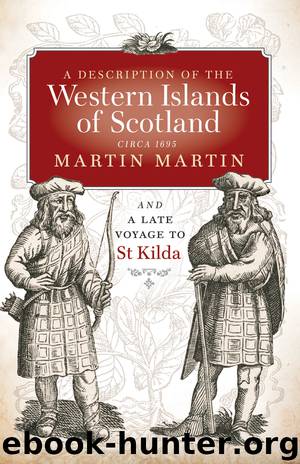A Description of the Western Isles by Martin Martin

Author:Martin Martin
Language: eng
Format: epub
Publisher: Birlinn
XIII
St Kilda, or Hirt
THE first of these names is taken from one Kilder, who lived here; and from him the large well Toubir-Kilda has also its name. Hirta is taken from the ier, which in that language signifies west: this isle lies directly opposite to the isles of North Uist, Harris, etc. It is reckoned eighteen leagues from the former, and twenty from Harries. This isle is by Peter Goas, in a map he made of it at Rotterdam, called St Kilder, it is the remotest of all the Scots north-west isles. It is about two miles in length, and one in breadth; it is faced all round with a steep rock, except the bay on the south-east, which is not a harbour fit for any vessel, though in the time of a calm one may land upon the rock, and get up into the island with a little combing. The land rises pretty high in the middle, and there is one mountain higher than any other part of the island. There are several fountains of good water on each side this isle. The corn produced here is oats and barley, the latter is the largest in the Western Isles.
The horses and cows here are of a lower size than in the adjacent isles, but the sheep differ only in the bigness of their horns, which are very long.
There is an ancient fort on the south end of the bay called Dunfir-Volg, i.e. ‘the fort of the Volscii’. This is the sense put upon the word by the antiquaries of the opposite isles of Uist.
The isle of Soa is nearly half a mile distant from the west side of St Kilda; it is a mile in circumference, very high and steep all round. Borera lies above two leagues north of St Kilda; it is near a mile in circumference, the most of it surrounded with a high rock. The largest and the two lesser isles are good for pasturage, and abound with a prodigious number of sea-fowl from March till September; the solan geese are very numerous here, insomuch that the inhabitants commonly keep yearly above twenty thousand young and old in their little stone houses, of which there are some hundreds for preserving their fowls, eggs, etc. They use no salt for preserving their fowl; the eggs of the sea wildfowl are preserved some months in the ashes of peats, and are astringent to such as be not accustomed to eat them.
The solan goose is in size somewhat less than a land goose, and of a white colour except the tips of the wings which are black, and the top of their head which is yellow; their bill is long, small pointed, and very hard, and pierces an inch deep into wood, in their descent after a fish laid on a board, as some use to catch them. When they sleep they put their head under their wings, but one of them keeps watch, and if that be surprised
Download
This site does not store any files on its server. We only index and link to content provided by other sites. Please contact the content providers to delete copyright contents if any and email us, we'll remove relevant links or contents immediately.
Cecilia; Or, Memoirs of an Heiress — Volume 2 by Fanny Burney(31909)
Cecilia; Or, Memoirs of an Heiress — Volume 3 by Fanny Burney(31888)
Fanny Burney by Claire Harman(26560)
We're Going to Need More Wine by Gabrielle Union(19002)
Plagued by Fire by Paul Hendrickson(17369)
All the Missing Girls by Megan Miranda(15770)
Cat's cradle by Kurt Vonnegut(15252)
Bombshells: Glamour Girls of a Lifetime by Sullivan Steve(14020)
For the Love of Europe by Rick Steves(13525)
Leonardo da Vinci by Walter Isaacson(13232)
4 3 2 1: A Novel by Paul Auster(12329)
The remains of the day by Kazuo Ishiguro(8887)
Adultolescence by Gabbie Hanna(8884)
Note to Self by Connor Franta(7645)
Diary of a Player by Brad Paisley(7520)
Giovanni's Room by James Baldwin(7250)
What Does This Button Do? by Bruce Dickinson(6167)
Ego Is the Enemy by Ryan Holiday(5344)
Born a Crime by Trevor Noah(5331)
